text and photos © by Susanna Gaertner
Our jumbo Airbus 340, on its recently inaugurated non-stop service from San Francisco to Zurich, with its exuberantly colorful markings is a novel sight. As I look down on it before departure, the man next to me wants to know what happened to the “sleek white and red design” and I assure him that this Big Bird will soon resume the elegant white plumage of all Swiss flyers…the dabs and daubs are just a new route advertisement. “Well, that’s fine then,” he says.
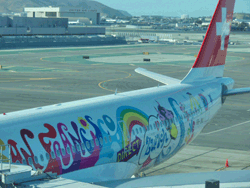
After a calm flight in the spacious new Business class accommodations which allow seats to turn into full-length beds, we are making our final descent over what is arguably some of the most beautiful aerial scenery in Europe. As the green rolling hills and prettily contained villages come closer they give off the rural peace which is characteristic for the farmlands of the German-speaking, eastern portion of the country: the Ostschweiz. While the Vaud and Vallais are generally cited when talking about Swiss wines (cf. “Swiss Idyll”), this report will focus on the Ostschweiz, where all is “correct yet comfortable,” which could serve as a motto for the entire country, as I experience it on every visit.
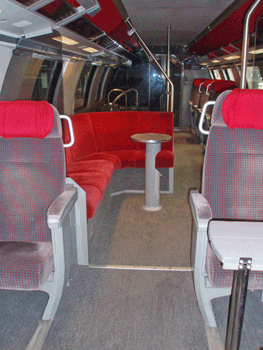 For I love Switzerland: all the order and cleanliness of Germany with none of the tension, historical baggage, and frequent urban decay. While Winston Churchill maintained that the only good thing to come out of Switzerland in the last 500 years was the cuckoo clock, he really didn’t live long enough to see the pastoral advantages in the creamy, unblemished beauty of this proud little nation that has certainly entered the 21st century. There is so much more here than cuckoo clocks! Not to mention the vibrant language: as a native German speaker I am fascinated with the regional dialects of Swiss German, which sound to a German ear much the way Australian sounds to an English speaker. There, “present” and “costume” become prezzie and cozzie…similarly, Schwiezerdeutsch is speckled with lively diminutives which lend objects a more endearing image: Schoggi instead of Schokolade, for example. In the food realm the dialect gives us such tongue pleasers as Aelpermagronen, Hoernli, Basler Laeckerli, Mostbroeckli, Gnagi, and Wiiguetzli (wine cookies), to name but a few.
For I love Switzerland: all the order and cleanliness of Germany with none of the tension, historical baggage, and frequent urban decay. While Winston Churchill maintained that the only good thing to come out of Switzerland in the last 500 years was the cuckoo clock, he really didn’t live long enough to see the pastoral advantages in the creamy, unblemished beauty of this proud little nation that has certainly entered the 21st century. There is so much more here than cuckoo clocks! Not to mention the vibrant language: as a native German speaker I am fascinated with the regional dialects of Swiss German, which sound to a German ear much the way Australian sounds to an English speaker. There, “present” and “costume” become prezzie and cozzie…similarly, Schwiezerdeutsch is speckled with lively diminutives which lend objects a more endearing image: Schoggi instead of Schokolade, for example. In the food realm the dialect gives us such tongue pleasers as Aelpermagronen, Hoernli, Basler Laeckerli, Mostbroeckli, Gnagi, and Wiiguetzli (wine cookies), to name but a few.
My stay is based in the historically rich city of St. Gallen, where traces of the 7th century can still be found. The cathedral, a UNESCO world cultural heritage site since 1983, will reward a visit to its ornate, vibrant, beautifully proportioned interior. It really is a gem and I am not normally agog over baroque ecclesiastical extravaganzas. Equally amazing is the 18th century Abbey Library with its exquisite rococo walnut carving: you have never seen anything like this.
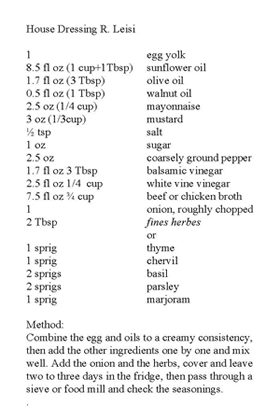 |
And then there’s the Textile Museum, which celebrates the city’s long tradition as a mercantile mecca of cloth and lace manufacture, a distinction which continues to the present: Cuban-American designer Isabel Toledo chose a guipure lace made in St. Gallen for Michelle Obama’s inauguration dress! That gorgeous yellow fabric came from here.
My first night at the elegant Einstein Hotel is, alas, anything but, as members of a wedding party run up and down the hallway half the night…not to mention the vocally amorous couple in the adjoining room. Next day I am relocated to the quiet of the 6th floor, where the silk curtains and premium cotton linens, the marmoreal quiet, high ceilings, and six-foot bathtub (a full-grown man could actually stretch out in this one) quickly override the hotel’s previous impression. Which continues to improve over the next few days with the hotel’s superb breakfast offerings and an appetizer of salad-and-Zander which I liked so much, I ate it every night. Zander, the dictionary tells me, is pike-perch, but I rather think it’s a freshwater fish that isn’t available in the U.S. Executive Chef Ralph Leisi has released his recipe for the sauce to Epicurean Traveler readers. Or you can simply come here to eat it!
For those who eschew posh hotels there’s the option of sleeping in a 15,000 litre (c.3963 gallons) wine barrel (Schlafen im Fass), “an opportunity to spend a night like Diogenes.” The barrels sleep 18, at a cost of c. $15 per adult and children over 6. And then there’s sleeping in the straw (Schlafen im Stroh) for those who wish to experience nature “close to the skin,” complete with the sounds and smells of the nearby cows, about 10 feet away from your berth on a long pallet filled with bales of hay that are topped off with fresh hay, “which we change daily.” I must say that the toilet facilities were clean and I’m certain the breakfast is excellent. Certainly, both of these choices allow you to optimize a vacation budget, but even the inns and hotels provide good value. For one thing, the price quoted is always per room, not per occupant, and includes breakfast for both; these collations will keep you sated through mid-afternoon. And the Swiss Rail Pass is good for virtually any public transport: local and intercity buses, trams, aerial trams, and of course all trains…given the frequency, cleanliness, reliability, and sheer comfort of public transport here, there is little reason to rent a car.
The trains are, for an American, marvels on rails: there is even a “quiet zone” within some cars, where conversation, radios, etc. are banned. And never, ever have I heard Muzak. The trains, which run on electricity, are also remarkably quiet: in conversation with a locomotive engineer I learned that these cars are made of an aluminum alloy, hence lighter than the loud, lumbering, teeth-rattling Amtrak monsters. Another reason for the relative quiet of Swiss trains — besides the superb regular automated maintenance — is the near universal use of continuously welded rails, totally eliminating the “clackety-clack” of the joints (in the US this noise is exacerbated by staggering the right and left-hand joinings, i.e., doubling the potential clacks!)
This region is perfect for wine travel, as the Ostschweiz doesn’t export its wines: “We produce so little and what we make we like to drink ourselves,” I was told more than once. The basic red is Pinot Noir—known here as Blauburgunder — and the regional white is Riesling Sylvaner, known elsewhere as Mueller-Thurgau after the vintner who popularized this hybrid grape back in 1882. A century later DNA testing showed that, while Riesling was indeed one of the parent plants, the other was not Silvaner but Chasselas de Courtillier (or possibly Madeleine Royale or Madeleine Angevine). In any event, Mueller Thurgau got a bad rap back in the ‘70s when it was used to make large quantities of low-grade Liebfraumilch. But those days are over and the grape has won back its chops.
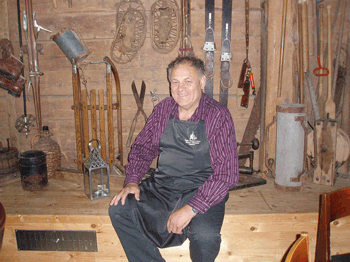
Peter Schmid
Unlike the Vaud and Valais, the vineyards in Eastern Switzerland are rarely visible from the road so “no one knows there’s wine available,” says Peter Schmid, “then we thought of letting people buy a grape vine — literally becoming godfather to a vine — so they could enjoy the fruits of their purchase.” Apparently it has worked well: production at Tobias Schmid & Sohn — founded in 1866 — is up to 200,000 bottles per year with many additions to their two “basic” Bernecker wines with their 96-year-old labels. The company has also paired wines with music, thus, for example, the cuvee rouge is concerto (g)rosso, one of the Pinots Noirs is amore sforzato, a dessert wine made from Joanniter grapes is Don Giovanni amabile, and so forth. Their “basic” Riesling Sylvaner (sometimes called “Rivaner”) is an aromatic, graceful white with a hint of dates and sultanas over a muscat base. I also tasted — right from the Fass — a mouth-mesmerizing meld of wine and spirits both smooth and electrifying and quite unlike anything I’ve ever tasted: this is Likoerwein and it takes Pinot Noir to new pinnacles; not surprisingly, this wine’s musical tag is “esprit vivace.”
I am eager to learn more about this unusual quaff, and winemaker Felix Indermaur elucidates the background: “The grapes for this wine come from our Rosenberg vineyard, a very steep slope abutting the winery and rising to the remnants of a once imposing fortress. The fortress, incidentally, was first mentioned in 1210, i.e., exactly 800 years ago,” he continues, “and our village of Berneck is even older, with documented mention of wine slopes (vinea) as early as 892. From caches of Roman coin we can assume that this area was well populated, even then.” I am tempted to think that some of those precious metals and all that history has infused this wine with its deep warmth and character.

Espirit Vivace Pinot Noir
Grown on 30-year old vines, the Esprit Vivace grapes are picked at the end of October or early November. Both the wine and the spirits are made from the Rosenberg Pinot grapes. “After pressing, the wine is briefly stored in steel tanks for the lees to settle, then poured into casks in our basement,” says Felix. “Our casks and barriques are all made of local (Rhine Valley) oak right here in Berneck by the fifth-generation Thurnheer cooperage. You are looking at casks that range in age from 10 to 100 years; the wine we just tasted was drawn from a 2000 litre (c. 528 gallons) cask that is 60 years old.”
When to add the brandy? That is the question. “It’s always exciting: that moment when we feel that the Weinbrand (70% alcohol) can be added to the young wine, since the brandy obviously stops further fermentation and we need to be reasonably certain that the residual sugars won’t spoil the fruit flavors,” Felix explains. “Incidentally, that was the 2006, which we have since bottled. Four years in the Fass but it should last 30 years in the bottle!”
Speaking of brandy, I must mention the Swiss national digestif, a superb concoction of herbs, which truly does soothe the stomach while pleasing the palate. With only 29% alcohol, the eponymous Appenzeller Alpenbitter is far milder than Jaegermeister or Fernet Branca but, unlike those two, AA is not for sale in the U.S. “According to the FDA, we would have to reclassify ourselves as a medicine (which is what the Germans and the Italians did),” I am told by their people, “and, since our customer base here knows us as a spirit, we just won’t go down that road.” So there. It is worth the half-hour bus trip to come here and taste not only the Alpenbitter but an array of drinks which they make with it.
***
Ochsen Torkel is the wonderfully descriptive name of an ancient wine press used in this region; it is also the name of a modern wine tasting room in the village of Thal, near St. Gallen. The young winemakers, Tom Kobel and his wife Salome Reimann, have revived several unusual grape varieties and produced some distinctive new wines, which you’ll have to come here to taste. Until 20 years ago only Riesling Sylvaner and Blauburgunder were allowed here, so other varieties are still a novelty: I’d never before encountered a Tante Hedy-Wy, made from a Pinot Noir Spaetlese, and a fiery Cuvee Rouge made from Pinot Noir, Cabernet Cortis, and Marechal Foch (a cold-hardy, early-ripening fungus-resistant grape that deepens and concentrates the vanilla and bitter chocolate notes).
Just as the Swiss have worked hard to remain neutral throughout any wars that nipped at their borders, so they are now adamant at repelling pests and pollutants from the environment. The Swiss equivalent to our Sustainable Food movement is Culinarium, a cooperative of loosely allied enterprises committed to the highest standards of purity and freshness in all areas of food production and consumption. I witnessed a serious effort to use only fresh, local produce, fish from neighboring streams and rivers, and beef from cattle fed on grass rather than grain. My lunch at the Culinarium-certified Jaeger Haus in Altenrhein was a taste sensation: fish caught that morning, vegetables picked moments before in the garden, the tart yet tame delight of a local Kerner white…the closest I’ve come to this here is the French Laundry, yet the “Culinarium effect” is pervasive in the Ostschweiz and doesn’t always cost an arm and a leg. Kerner, incidentally, is a variety found only is Switzerland: Riesling crossed with Trollinger (a red grape from Germany). With its gooseberry aroma and mild flintiness, it’s the perfect accompaniment to robust fish dishes, as the puckering acidity of the Trollinger swims up against the very mildest of residual sugar in the Riesling. An excellent example is the 2009 Buchberg AOC Kerner from Christoph Rutishauser in Thal.
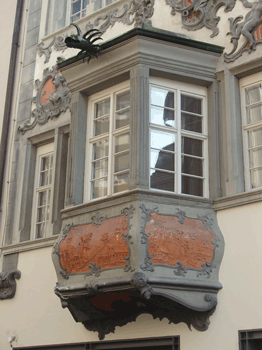
One of the many ornate oriels (bay windows) found in Schaffhausen
The bus or train will take you to Hallau, a wine-centric village 15 km northwest of Schaffhausen (pop. 7000), which in turn is about an hour northwest of St. Gallen (pop. 30,000). Hallau exhibits some of the prettiest scenery I saw on my entire trip: plump green folds of gently undulating land with postcard-worthy cows, thriving vines, church spires…truly a pastoral Eden. Stop at the Vinothek Hallau for a taste of several wineries’ produce, or visit the wineries themselves…you will want to make prior arrangements with Hallau Tourism.
Situated on a little floret of land surrounded on three sides by Germany, Schaffhausen (pop. 35,000)retains its historic character with an abundance (over 150!) of broad, boxy, gaily painted bay windows known as oriels, which served as status symbols to the medieval burghers. The town originally gained prominence as a portage site for goods carried overland here where the Rhine breaks its smooth meander and erupts into the famous Rhine Falls, eulogized by generations of travelers, including John Ruskin, who first visited in 1833 when he was fourteen. He marveled at the sight of the Alps and “went down that evening from the garden-terrace of Schaffhausen with my destiny fixed.” Ruskin (1819-1900) visited often and wrote with onomatopoeic rapture about the cataracts:
Stand for half an hour beside the fall of Schaffhausen, on the north side, where the rapids are long, and watch how the vault of water first bends, unbroken, in pure velocity, over the arching rocks at the brow of the cataract, covering them with a dome of crystal twenty feet thick, so swift that its motion is unseen except when a foam-globe from above darts over it like a fallen star…. –Modern Painters, Vol I, Part 2, 1843
For a panoramic view of the region, climb to the Munot, an 11th century hilltop castle/fortress whichstill boasts a municipal watchman tolling a bell every night at 9 o’clock. My guide tells me that the current watchman’s wife hails from NYC and I can but wonder how she transitioned to making her home in this stark, gray, imposing edifice. I imagine that the surrounding scenic delights of this medieval gem are compensation enough.
& & &
Resources:
